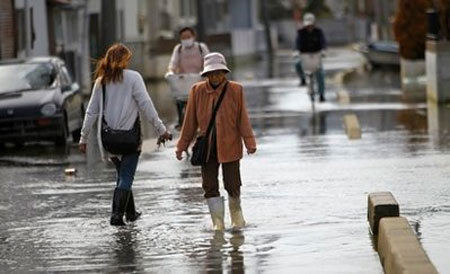The tide 'invades' many Japanese cities after the earthquake
When the water began to creep across the coastal streets, Yoshiko Takahashi knew it was time to hurry home.
Every day, the water rises again until the ankle is flooded, carrying fish, fragments to Takahashi's door, "burying" everyone in the house. And those who are still on the road must bury in the sea with rubber boots or avoid water by riding a bicycle.
' I looked through the window, the scene was like our house in the middle of the ocean, ' Takahashi said. She moved to Ishinomaki City three years ago.
The earthquake on March 11 attacked the eastern Japan so strongly that it pulled the entire sun country to the sea and subsided deeper . Coastal communities are almost flattened now facing frequent flooding. In port cities like Onagawa and Kesennuma, the tide visited and then withdrew from the ruined houses along the streets of the people.

The street is flooded with tidal water in Ishinomaki City, Miyagi Prefecture, on May 3.
A group of residents in Ishinomaki city luckily escaped the wrath of tsunami, thanks to the special terrain. So many people still live in their homes. But now they face a daily problem: Flooding due to high tide , making the streets peaceful all the time when people rush to return home before high tide.
' I tried to go shopping for everything before 3pm , ' said Takuya Kondo, 32, said.
Most houses are located on the 'reach' of the tide, but vehicles pass by making waves come into the house, the sewage is flooded, making the toilet unusable. Meanwhile, scientists think this situation will be permanent .
The northern half of Japan lies on the North American tectonic plate. The Pacific Pacific, mostly under the sea, often slips under North America, gradually pushing Japan to the west. But in the earthquake on March 11, the floor between the two terraces was broken, the North American ground slid up and out, along the Pacific Pacific.
The protruding edge of the plain made the seabed off the east coast of Japan rise, but according to Tohoku University's measurements of 5 meters, a tsunami devastated the Japanese coast. The level of the bottom of Japan is pulled low when it slides to the sea, causing Japan to be pulled down as well.
Some areas in Ishinomaki were shifted to southeast 5.3m and subsided to 1.2m.
' We think that the phenomenon of sliding out to this sea will happen slowly. We do not expect it to happen strongly at the same time , "said Testuro Imakiire, a researcher at the Japan Geological Information Agency, the agency responsible for government survey and mapping.
According to Imakiire, t lacks earthquakes so strong that it moves the entire country . This was the first such occurrence, when authorities began to measure in the late 19th century. In Tokyo, 340km from Ishinomaki, many areas were displaced to the 24cm sea.
Meanwhile, subsidence occurred most strongly around Ishinomaki, the area closest to the epicenter. The effect of this phenomenon can be clearly seen: the manholes are raised on the street, the electric pole is deeply sunk, causing the wire to be on top of the head.
When the surrounding area cleared up the rubble, planned to rebuild, the people in Ishinomaki area seemed to be "deadly". Their houses were almost undamaged, unqualified to receive government insurance or support, but twice a day the tide visited their streets.
' We can't complain, because others lose a lot, ' said Yuichiro Mogi, 43.
The March 11 earthquake / tsunami has left more than 25,000 people dead and missing and tens of thousands of people have lost their homes and properties.
- Flood tide threatens 21 great cities
- Announcing the cause of Japanese 2011 earthquake super
- Japan was again shaken by the second earthquake
- Tokyo shakes because of the earthquake
- Japan again shook because of the 6.1-magnitude earthquake
- Three Japanese cities were wiped out
- The magnitude of the magnitude 5.9 earthquake shook Fukushima
- A strong earthquake may occur in North Tokyo Bay
- Japan warns of the impact of a potential earthquake
- What is the black tide? Causes and ways to overcome the black tide
- Tokyo will suffer an additional big earthquake
- Red tide and harmful effects on seafood production
 Is the magnetic North Pole shift dangerous to humanity?
Is the magnetic North Pole shift dangerous to humanity? Washington legalizes the recycling of human bodies into fertilizer
Washington legalizes the recycling of human bodies into fertilizer Lightning stone - the mysterious guest
Lightning stone - the mysterious guest Stunned by the mysterious sunset, strange appearance
Stunned by the mysterious sunset, strange appearance